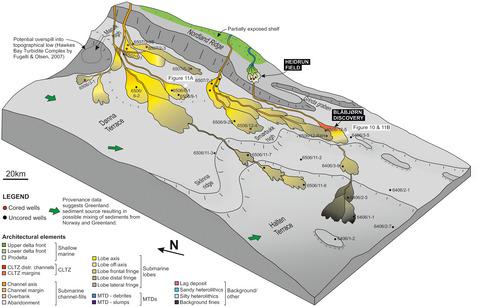当前位置:
X-MOL 学术
›
Basin Res.
›
论文详情
Our official English website, www.x-mol.net, welcomes your feedback! (Note: you will need to create a separate account there.)
Mixed axial and transverse deep-water systems: The Cretaceous post-rift Lysing Formation, offshore Norway
Basin Research ( IF 3.2 ) Pub Date : 2021-02-15 , DOI: 10.1111/bre.12555 L. A. S. Hansen 1 , D. M. Hodgson 1 , A. Pontén 2 , C. Thrana 2 , A. Obradors Latre 3
Basin Research ( IF 3.2 ) Pub Date : 2021-02-15 , DOI: 10.1111/bre.12555 L. A. S. Hansen 1 , D. M. Hodgson 1 , A. Pontén 2 , C. Thrana 2 , A. Obradors Latre 3
Affiliation

|
Deep-water stratigraphic successions from syn- to post-rift stages are an archive of evolving physiographic configurations, and can record axial and transverse sedimentary sources. The healing of topography decreases the influence of syn-rift structures on sedimentation patterns and transport processes over time, which leads to a long-term transition from dominantly axial to transverse dispersal patterns. The Halten and Dønna terraces, offshore mid-Norway, comprise a series of rift-related sub-basins established during the Jurassic, which were infilled with sediments during the Cretaceous. The Cretaceous Lysing Formation developed as slope- and basin-floor fans within a series of weakly confined post-rift sub-basins with some shallow marine deposits interpreted on the basin margins. A deep-water setting is supported by seismic interpretation, and bed type and architectural element analysis in all cored and uncored wells in the area. We document that an axial submarine fan system was active throughout the post-rift stage due to subtle inherited topography from syn-rift structures, which interacted with locally sourced transverse sediment sources. This led to a complicated stratigraphic architecture, with lobe fringe deposits of the axial fan system juxtaposed with channel-fills and channel-lobe transition zone deposits of transverse systems. The refined palaeogeographic reconstruction of the Lysing Formation illustrates how subtle topography can impact sediment routing patterns many millions of years after the end of rifting and can be used for palaeoenvironmental interpretations in other post-rift settings.
中文翻译:

混合轴向和横向深水系统:白垩纪裂谷后裂解地层,挪威近海
从裂谷前阶段到裂谷后阶段的深水地层序列是演化地貌构造的档案,可以记录轴向和横向沉积源。随着时间的推移,地形的愈合降低了同裂谷结构对沉积模式和输运过程的影响,这导致了从占主导地位的轴向扩散模式到横向扩散模式的长期转变。位于挪威中部近海的 Halten 和 Dønn 阶地包括一系列在侏罗纪建立的与裂谷相关的亚盆地,这些亚盆地在白垩纪被沉积物填充。白垩纪裂解组在一系列弱封闭的裂谷后亚盆地内发育为斜坡和盆底扇,在盆地边缘解释了一些浅海沉积物。地震解释支持深水环境,以及该地区所有有芯井和无芯井的地层类型和建筑元素分析。我们记录了一个轴向海底扇系统在整个裂谷后阶段活跃,这是由于来自同裂谷结构的微妙继承地形,与当地来源的横向沉积物源相互作用。这导致了复杂的地层结构,轴流扇系统的叶状边缘沉积物与横向系统的通道填充物和通道-叶状过渡带沉积物并置。Lysing 组的精细古地理重建说明了在裂谷结束后数百万年,微妙的地形如何影响沉积物路径模式,并可用于其他裂谷后环境中的古环境解释。
更新日期:2021-02-15
中文翻译:

混合轴向和横向深水系统:白垩纪裂谷后裂解地层,挪威近海
从裂谷前阶段到裂谷后阶段的深水地层序列是演化地貌构造的档案,可以记录轴向和横向沉积源。随着时间的推移,地形的愈合降低了同裂谷结构对沉积模式和输运过程的影响,这导致了从占主导地位的轴向扩散模式到横向扩散模式的长期转变。位于挪威中部近海的 Halten 和 Dønn 阶地包括一系列在侏罗纪建立的与裂谷相关的亚盆地,这些亚盆地在白垩纪被沉积物填充。白垩纪裂解组在一系列弱封闭的裂谷后亚盆地内发育为斜坡和盆底扇,在盆地边缘解释了一些浅海沉积物。地震解释支持深水环境,以及该地区所有有芯井和无芯井的地层类型和建筑元素分析。我们记录了一个轴向海底扇系统在整个裂谷后阶段活跃,这是由于来自同裂谷结构的微妙继承地形,与当地来源的横向沉积物源相互作用。这导致了复杂的地层结构,轴流扇系统的叶状边缘沉积物与横向系统的通道填充物和通道-叶状过渡带沉积物并置。Lysing 组的精细古地理重建说明了在裂谷结束后数百万年,微妙的地形如何影响沉积物路径模式,并可用于其他裂谷后环境中的古环境解释。


























 京公网安备 11010802027423号
京公网安备 11010802027423号